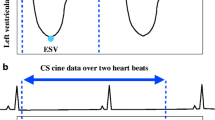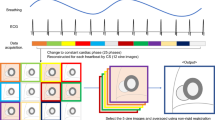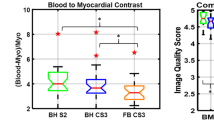Abstract
Objectives
This study was conducted in order to evaluate the accuracy of a compressed sensing (CS) real-time single-breath-hold cine sequence for the assessment of left and right ventricular functional parameters in daily practice.
Methods
Cardiac magnetic resonance (CMR) cine images were acquired from 100 consecutive patients using both the reference segmented multi-breath-hold steady-state free precession (SSFP) acquisition and a prototype single-breath-hold real-time CS sequence, providing the same slice number, position, and thickness. For both sequences, the left (LV) and right ventricular (RV) ejection fractions (EF) and end-diastolic volumes (EDV) were assessed as well as LV mass (LVM). The visualization of wall-motion disorders (WMD) and signal void related to mitral or tricuspid regurgitation was also analyzed.
Results
The CS sequence mean scan time was 23 ± 6 versus 510 ± 109 s for the multi-breath-hold SSFP sequence (p < 0.001). There was an excellent correlation between the two sequences regarding mean LVEF (r = 0.995), LVEDV (r = 0.997), LVM (r = 0.981), RVEF (r = 0.979), and RVEDV (r = 0.983). Moreover, inter- and intraobserver agreements were very strong with intraclass correlations of 0.96 and 0.99, respectively. On CS images, mitral or tricuspid regurgitation visualization was good (AUC = 0.85 and 0.81, respectively; ROC curve analysis) and wall-motion disorder visualization was excellent (AUC ≥ 0.97).
Conclusion
CS real-time single-breath-hold cine imaging reduces CMR scan duration by almost 20 times in daily practice while providing reliable measurements of both left and right ventricles. There was no clinically relevant information loss regarding valve regurgitation and wall-motion disorder depiction.
Key Points
• Compressed sensing single-breath-hold real-time cine imaging is a reliable sequence in daily practice.
• Fast CS real-time imaging reduces CMR scan time and improves patient workflow.
• There is no clinically relevant information loss with CS regarding heart valve regurgitation or wall-motion disorders.





Similar content being viewed by others
Abbreviations
- ARVC:
-
Arythmogenic right ventricular cardiomyopathy
- CMR:
-
Cardiac magnetic resonance
- CS:
-
Compressed sensing
- ECG:
-
Electrocardiogram
- EDV:
-
End-diastolic volume
- EF:
-
Ejection fraction
- GPU:
-
Graphic processing unit
- LV/LVEF/LVEDV:
-
Left ventricle/left ventricular EF/left ventricular EDV
- LVM:
-
Left ventricular mass
- RV/RVEF/RVEDV:
-
Right ventricle/right ventricular EF/right ventricular EDV
- SD:
-
Standard deviation
- SSFP:
-
Balanced steady-state free precession
- WMD:
-
Wall-motion disorders
References
Pennell DJ, Sechtem UP, Higgins CB et al (2004) Clinical indications for cardiovascular magnetic resonance (CMR): consensus panel report. Eur Heart J 25:1940–1965. https://doi.org/10.1016/j.ehj.2004.06.040
Maceira AM, Prasad SK, Khan M, Pennell DJ (2006) Normalized left ventricular systolic and diastolic function by steady state free precession cardiovascular magnetic resonance. J Cardiovasc Magn Reson 8:417–426. https://doi.org/10.1080/10976640600572889
Maceira AM, Prasad SK, Khan M, Pennell DJ (2006) Reference right ventricular systolic and diastolic function normalized to age, gender and body surface area from steady-state free precession cardiovascular magnetic resonance. Eur Heart J 27:2879–2888. https://doi.org/10.1093/eurheartj/ehl336
Plein S, Bloomer TN, Ridgway JP et al (2001) Steady-state free precession magnetic resonance imaging of the heart: comparison with segmented k-space gradient-echo imaging. J Magn Reson Imaging 14:230–236. https://doi.org/10.1002/jmri.1178
Nacif MS, Zavodni A, Kawel N, Choi EY, Lima JA, Bluemke DA (2012) Cardiac magnetic resonance imaging and its electrocardiographs (ECG): tips and tricks. Int J Cardiovasc Imaging 28:1465–1475. https://doi.org/10.1007/s10554-011-9957-4
Lustig M, Donoho D, Pauly JM (2007) Sparse MRI: the application of compressed sensing for rapid MR imaging. Magn Reson Med 58:1182–1195. https://doi.org/10.1002/mrm.21391
Vincenti G, Monney P, Chaptinel J et al (2014) Compressed sensing single-breath-hold CMR for fast quantification of LV function, volumes, and mass. JACC Cardiovasc Imaging 7:882–892. https://doi.org/10.1016/j.jcmg.2014.04.016
Allen BD, Carr M, Botelho MP et al (2016) Highly accelerated cardiac MRI using iterative SENSE reconstruction: initial clinical experience. Int J Cardiovasc Imaging 32:955–963. https://doi.org/10.1007/s10554-016-0859-3
Bogachkov A, Ayache JB, Allen BD et al (2016) Right ventricular assessment at cardiac MRI: initial clinical experience utilizing an IS-SENSE reconstruction. Int J Cardiovasc Imaging 32:1081–1091. https://doi.org/10.1007/s10554-016-0874-4
Camargo GC, Erthal F, Sabioni L et al (2017) Real-time cardiac magnetic resonance cine imaging with sparse sampling and iterative reconstruction for left-ventricular measures: comparison with gold-standard segmented steady-state free precession. Magn Reson Imaging 38:138–144. https://doi.org/10.1016/j.mri.2017.01.002
Goebel J, Nensa F, Bomas B et al (2016) Real-time SPARSE-SENSE cardiac cine MR imaging: optimization of image reconstruction and sequence validation. Eur Radiol 26:4482–4489. https://doi.org/10.1007/s00330-016-4301-y
Haubenreisser H, Henzler T, Budjan J et al (2016) Right ventricular imaging in 25 seconds: evaluating the use of sparse sampling CINE with iterative reconstruction for volumetric analysis of the right ventricle. Invest Radiol 51:379–386. https://doi.org/10.1097/RLI.0000000000000250
Goebel J, Nensa F, Schemuth HP et al (2016) Compressed sensing cine imaging with high spatial or high temporal resolution for analysis of left ventricular function. J Magn Reson Imaging 44:366–374. https://doi.org/10.1002/jmri.25162
Lin ACW, Strugnell W, Riley R et al (2017) Higher resolution cine imaging with compressed sensing for accelerated clinical left ventricular evaluation. J Magn Reson Imaging 45:1693–1699. https://doi.org/10.1002/jmri.25525
Baker C (2016) Investigation of sparsifying transforms in compressed sensing for magnetic resonance imaging with FastTestCS. Theses and Dissertation 1347, University of Wisconsin, Milwaukee
Klinke V, Muzzarelli S, Lauriers N et al (2013) Quality assessment of cardiovascular magnetic resonance in the setting of the European CMR registry: description and validation of standardized criteria. J Cardiovasc Magn Reson 15:55–67. https://doi.org/10.1186/1532-429X-15-55
Larson AC, Kellman P, Arai A et al (2005) Preliminary investigation of respiratory self-gating for free-breathing segmented cine MRI. Magn Reson Med 53:159–168. https://doi.org/10.1002/mrm.20331
Wetzl J, Schmidt M, Pontana F et al (2017) Single-breath-hold 3-D CINE imaging of the left ventricle using Cartesian sampling. MAGMA. https://doi.org/10.1007/s10334-017-0624-1
Cerqueira MD, Weissman NJ, Dilsizian V et al (2002) Standardized myocardial segmentation and nomenclature for tomographic imaging of the heart. A statement for healthcare professionals from the Cardiac Imaging Committee of the Council on Clinical Cardiology of the American Heart Association. Circulation 105:539–542. https://doi.org/10.1161/hc0402.102975
Kido T, Kido T, Nakamura M et al (2016) Compressed sensing real-time cine cardiovascular magnetic resonance: accurate assessment of left ventricular function in a single-breath-hold. J Cardiovasc Magn Reson 18:50–60. https://doi.org/10.1186/s12968-016-0271-0
Sudarski S, Henzler T, Haubenreisser H et al (2017) Free-breathing sparse sampling cine MR imaging with iterative reconstruction for the assessment of left ventricular function and mass at 3.0 T. Radiology 282:74–83. https://doi.org/10.1148/radiol.2016151002
Kido T, Kido T, Nakamura M et al (2017) Assessment of left ventricular function and mass on free-breathing compressed sensing real-time cine imaging. Circ J 81:1463–1468. https://doi.org/10.1253/circj.CJ-17-0123
Goebel J, Nensa F, Schemuth HP et al (2017) Real-time SPARSE-SENSE cine MR imaging in atrial fibrillation: a feasibility study. Acta Radiol 58:922–928. https://doi.org/10.1177/0284185116681037
Semelka RC, Tomei E, Wagner S et al (1990) Normal left ventricular dimensions and function: interstudy reproducibility of measurements with cine MR imaging. Radiology 174:763–768. https://doi.org/10.1148/radiology.174.3.2305059
Gardner BI, Bingham SE, Allen MR, Blatter DD, Anderson JL (2009) Cardiac magnetic resonance versus transthoracic echocardiography for the assessment of cardiac volumes and regional function after myocardial infarction: an intrasubject comparison using simultaneous intrasubject recordings. Cardiovasc Ultrasound 7:38–44. https://doi.org/10.1186/1476-7120-7-38
Rösner A, Barbosa D, Aarsæther E, Kjønås D, Schirmer H, D'hooge J (2015) The influence of frame rate on two-dimensional speckle-tracking strain measurements: a study on silico-simulated models and images recorded in patients. Eur Heart J Cardiovasc Imaging 16:1137–1147. https://doi.org/10.1093/ehjci/jev058
Funding
The authors state that this work has not received any funding.
Author information
Authors and Affiliations
Corresponding author
Ethics declarations
Guarantor
The scientific guarantor of this publication is Francois Pontana.
Conflict of interest
The authors of this manuscript declare relationships with the following companies: Mathilde Vermersch, Benjamin Longère, Augustin Coisne, Julien Pagniez, Valentina Silvestri, Arianna Simeone, Emma Cheasty, David Montaigne, and François Pontana have no competing interest. They are employed by an institution engaged in contractual collaboration with Siemens Healthcare. Michaela Schmidt, Christoph Forman, and Aurelien Monnet are employees of Siemens Healthcare GmbH.
Statistics and biometry
One of the authors has significant statistical expertise.
Informed consent
Written informed consent was obtained from all patients in this study.
Ethical approval
Institutional Review Board approval was obtained.
Methodology
• prospective
• cross-sectional study
• performed at one institution
Additional information
Publisher’s note
Springer Nature remains neutral with regard to jurisdictional claims in published maps and institutional affiliations.
Electronic supplementary material
ESM 1
(DOCX 41619 kb)
Rights and permissions
About this article
Cite this article
Vermersch, M., Longère, B., Coisne, A. et al. Compressed sensing real-time cine imaging for assessment of ventricular function, volumes and mass in clinical practice. Eur Radiol 30, 609–619 (2020). https://doi.org/10.1007/s00330-019-06341-2
Received:
Revised:
Accepted:
Published:
Issue Date:
DOI: https://doi.org/10.1007/s00330-019-06341-2




